62 Brunswick Street West, Bow Street Runner, ex-The Station Inn
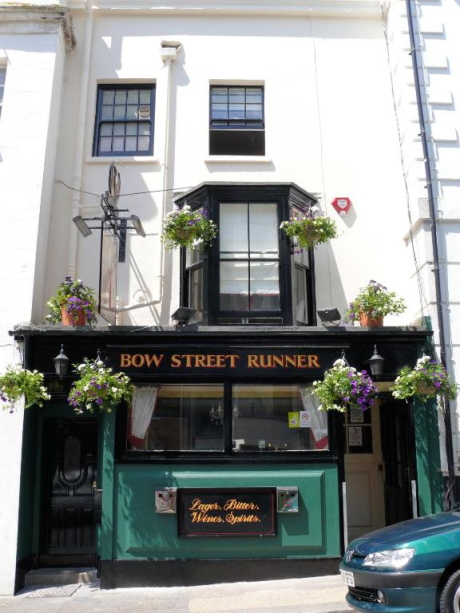
The Bow Street Runner circa 2020
The Station Inn was the last of three licensed premises to open on Brunswick Street West; the others being the Star of Brunswick 1824 and the Denmark Tavern circa 1864; (the Freemasons Tavern, circa 1850’s, is sometimes included because of its position on the north east corner of Brunswick Street West although the entrance is on Western Road). Classed as a ‘beerhouse’ the Station Inn first appears in the street directories in 1867 as number 2 Brunswick Street West. A report in the Brighton Gazette indicates that the Station Inn was operating in October 1866.The first reference to this building though appear in a series of announcements in the Brighton Gazette in August 1857. These refer to an auction of the freehold of a ‘dwelling house at 2 Brunswick Street West, Hove, adjoining the Town Hall’.
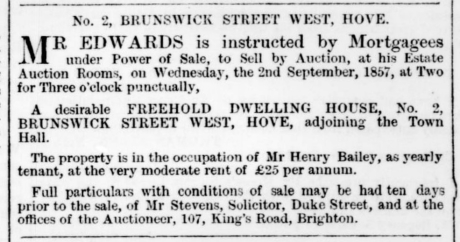
Brighton Gazette Thursday 13 August 1857
A Mr Henry Bailey is listed as a yearly tenant of the dwelling house paying a ‘moderate rent’ of £25 per annum. In the Brighton Gazette 25 November 1858 the freehold is again advertised for sale by auction. This time the tenant is not named specifically but is described as a ‘highly responsible tenant’, the annual rent being listed as £20. Henry Bailey is described as a ‘clerk in service’, and in the 1861 census he is still listed as living in the house with his wife and two children. In the 1851 census Henry Bailey was listed as residing at ‘stables in Brunswick Street West’ and it was in this year that he married Mary Reeves. In addition the 1861 census lists a second family, John Chilcott, a coachman, and his daughter as living in the house.
The building
The exact date when the building was erected is unclear, however, an entry in the Brunswick Commissioners minutes for January 5th 1855 records that a ‘Mr Martin had consented to sell his freehold house ‘adjoining the south side of the present building belong to the Commissioners in Brunswick Street West and that Mr Martin was prepared to give possession on completion of the purchase’. This is in preparation for the 1855-56 extension of the Brunswick Town Hall and it is assumed the ‘freehold house’ was demolished to provide the necessary land.
There are certain aspects to the building which suggest that it was built at the same time or shortly after the extension to Brunswick Town Hall. One of the distinguishing features is the way the building is recessed behind the front elevation of the town hall. It is possible that the Commissioners did not want the decorative architectural features of the new building i.e. corner quoin stones, to be masked or covered by another building, although this has occurred on the northern corner of the building.
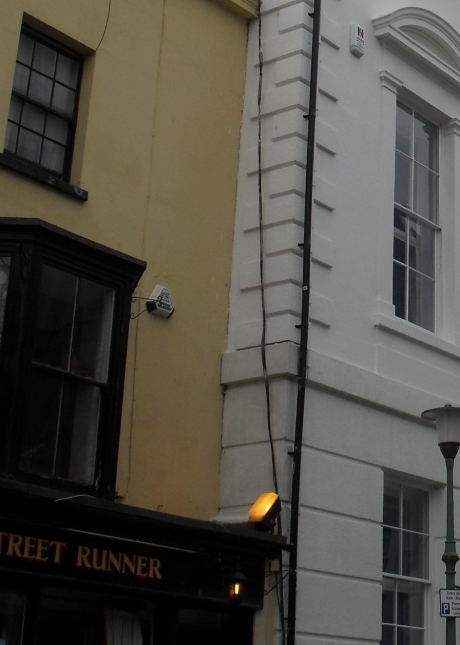
Positioning of the two buildings
The front elevation shows a simple design reminiscent of a typical small terraced house; one central window on each of the three floors with a ground floor door off centre. The current ‘pub’ frontage of the building has a large centre window and stall riser positioned slightly forward of the front elevation with a door on either side. On the first floor is a central canted bay window; it is possible that this was not an original feature but added at the same time as the pub frontage and the additional ground floor door, the date of these alterations have yet to be found. The additional off centre second floor window was inserted in 1952 when a new bathroom was built on the second floor.
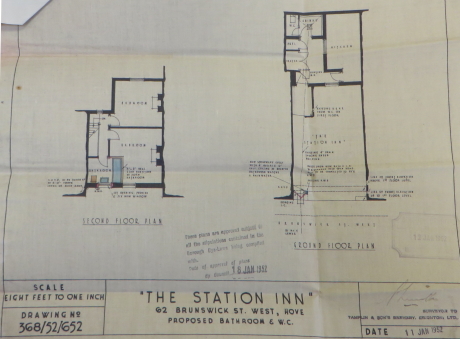
Plans of intended alterations 11th January 1952
The number conundrum
In the 1851 census Silvanus Scourfield and his wife Martha are listed as living at number 2 Brunswick Street West, down the street from the Police Station and one other house (which was demolished in the mid-1850s to build the new Town Hall. Sylvanus retired here on a military pension and may have been the first person of modest means to retire to Hove
The first time the number 2 is specifically linked to the site of the Station Inn is the newspaper announcements of 1857. The numbers in Brunswick Street West are confusing because the four properties in the section of the road leading to Lansdowne Place are sometimes numbered as 1 to 4 in addition to those at the top of the road. For example, in the 1852 street directory James Munger, greengrocer, is listed at living in number 2; the Star of Brunswick is listed as number 3.
The 1921 census also lists two properties with the address 2 Brunswick Street West. One is the Station Inn; the second records it as ‘2 Brunswick Street West – off Lansdowne Place’. It is likely that this could be the number 2 referred to in the records of James Munger. In 1925 the street number for the Station Inn was changed to 62 Brunswick Street West.
A Beerhouse
The Station Inn was classed as a beerhouse or shop. Beerhouses came into existence following the introduction of The Beerhouse Act (1 Will. IV, c.64 1830). The aim was to reduce the consumption of gin by the working class and promote the drinking of beer which was considered less of an evil. Beer had previously been taxed and the act abolished this tax. Beerhouses required a license to operate and were under the control of the local justices; any ratepayer could apply for a license at an annual Excise fee of two guineas. English Heritage state that by the end of the year of the Act coming into force there were 24,342 new beer sellers in England rising to 33,515 in 1832.
Beerhouses were only licensed to sell beer, not wine or spirits. The popularity of beer houses is reflected by the opening of both the Denmark Tavern and Station Inn on Brunswick Street West in the 1860’s. Many beerhouses had a very simple layout and this can be seen on the floor plans above, which, although from the 1950’s, still illustrates that the public area of the Station Inn was effectively a single room on the ground floor.
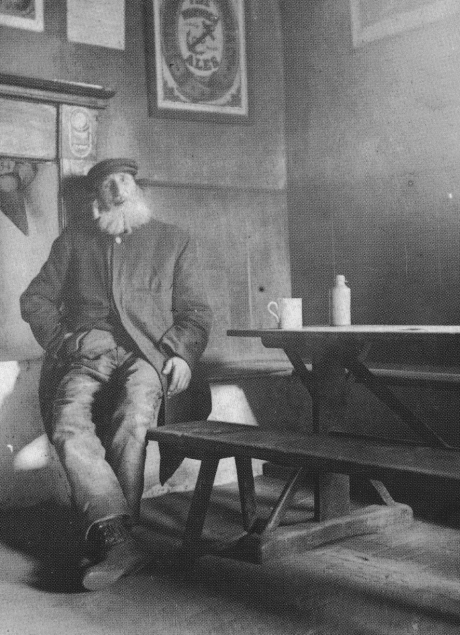
Typical interior of a beerhouse circa 1900. c. English Heritage
So far no evidence of a license being given to the Station Inn has been found, however, on September 1st 1871, Eliza Barnett, widow of John Barnett granted a 35-year lease on the Station Inn to John Mills Kidd and Frederick James Kidd brewers for the ‘yearly sum of twenty-four pounds’. In addition to the Station Inn ten other licensed premises had their leases sold. These include the Montpelier Inn public house, Montpelier Place and the Brunswick Inn public house, Holland Road, Hove.
John Barnett had founded the Cannon Brewery in Russell Street in 1821 and established a chain of pubs across the Brighton and Hove area. The Station Inn was one of these establishments and it is very likely that the Barnett’s were responsible for establishing the Station Inn in the 1860’s which may explain the licensing for the beerhouse. In the 1851 census John and Eliza Barnett are listed as living at Brunswick House and his occupation is given as a ’brewer’ and in 1871, the year he died, they are listed as living at 43 Brunswick Terrace.
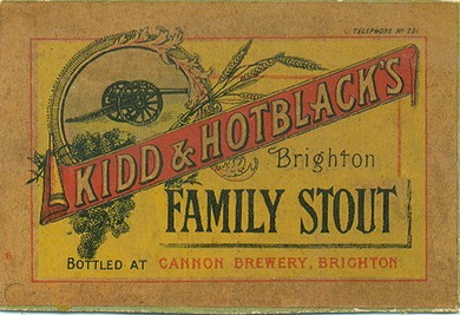
Kidd & Hotblack's Family Stout bottle label circa 1916
After purchasing the leases from Eliza Barnett, brothers John Mills Kidd and Frederick James Kidd were responsible for managing the Cannon Brewery until 1884 when it became the Kidd & Hotblacks Brewery. The company was taken over in 1926 by Brighton’s largest brewer Tamplin & Sons which itself was bought by Watney Mann in 1953. The Bow Street Runner is currently a Harvey of Lewes pub.
The landlords
The first landlord of the Station Inn, listed in the 1867 newspaper report and street directories, is William Pennicott. In the 1861 census William, his wife and four children are listed as living in the Parish of West Chiltington and his occupation is listed as a tailor. In the 1871 census, after a short period at the Station Inn (1866-1868), William and his family have moved into ‘Lansdowne Cottage and Tailor Shop attached’. He is again listed as a tailor, as is his oldest son William. They are listed in the electoral rolls and street directories at this address until 1879 and in the 1881 census William and his family are listed as living and working as a tailor in Storrington.
Between 1869and 1877 the landlord is William Young. In the 1871 census the Station Inn is referred to as the ‘Town Hall Beer House’, although it is still listed as number 2 Brunswick Street West. The censuses for 1881 and 1891 list William Young as ‘Inn Keeper/Livery Stable Keeper’ at the Brunswick Inn Holland Road. In the 1911 census he is listed as residing in Portslade and living on ‘private means’.
Alfred Holkham was the next landlord of the Station Inn between 1878 and 1883. In the 1881 census Alfred and his wife are listed along with two boarders and his occupation is given as ‘beerhouse keeper’. Alfred died in November 1890 and in his probate record he is listed as a licensed victualler and the landlord of the Montpelier Inn.
1884 saw the arrival of Charles T Alexander to the Station Inn and this was the start of a family link to the Station Inn which lasted until the early 1950’s. In the census for 1881 Charles and his family are listed as living at 3 Palmeira Mews and his occupation is listed as a ‘coachman’. In the 1891 census Charles, aged 46, is listed at the Station Inn along with his wife Louisa, aged 52, three children; Charles aged 20, Elizabeth aged 16 and Alice aged 12, a cousin and a lodger. Charles’s occupation is listed as a ’publican’.
In 1895 the eldest daughter of Charles Alexander; Elizabeth Louisa, married Frederick Linfield. In the same year the street directory records Frederick Linfield as the landlord of the Station Inn. In the 1901 census he is recorded along with his wife and two children at the Station Inn, his occupation given as ‘beer retailer/pub’. Charles Alexander, his wife and youngest daughter Alice are listed as living at 41 Brunswick Street West with his occupation now listed as ‘cab driver/groom’.
The tenure of Frederick Linfield as landlord ended in 1903. Dying at the age 35 his funeral is reported in the Brighton Gazette on 7th February 1903. From 1903 his wife Elizabeth Louisa is listed as the landlady of the Station Inn until she is sadly recorded as dying at the age of 35 in March 1910.
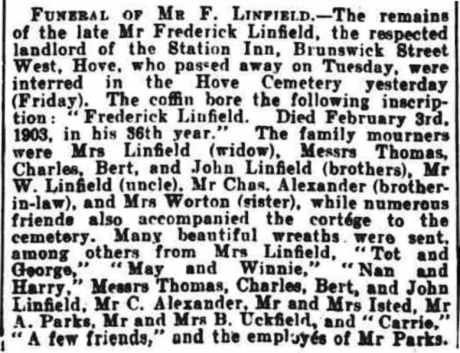
Brighton Gazette 07 February 1903
From 1910 Charles T Alexander is again listed in the street directories as landlord of the Station Inn until 1923. In the census of 1911 he is listed as a widower living with his daughter Alice aged 32 and two grandchildren; May and Alice Lindfield, aged 15 aged 13 respectively. Charles’s occupation is given as ‘beer retailer’ and Alice is listed as ‘manageress to above’. In addition to the Alexander family a visitor, G. Pudney, is listed on the census.
On 28th July 1918 Frederick George Pudney is recorded as marrying Alice Emily Alexander of 2 Brunswick Street West. On the following day, 29th July 1918, Frederick, a reservist, enlisted with the Army Service Corps Mechanical Transport Companies. On the form his full address is given as 2 Brunswick Street West, Hove and interestingly his given occupation is ‘pub proprietor’. To the question ‘have you ever served in any branch of His Majesty’s Forces’ he answers ‘no’. In the 1921 census Charles T Alexander, now aged 77 is listed as an ‘inn keeper’. His daughter Alice Pudney and her husband Frederick George Pudney are both listed as living at the Station Inn; Frederick’s occupation is listed as ‘cab proprietor’. Charles T Alexander died in October 1923 at the age of 79.

George Pudney with his niece and nephew Joyce and Sidney Brown outside the Station Inn 1927. The Kidd & Hotblack sign below the window was changed to read Station Inn the following year. (Courtesy of Philip Godsiff)
On the death of Charles T Alexander his daughter and son-in-law take over the running of the Station Inn. The street directory lists Frederick G Pudney as landlord under the title ‘beer retailer’. Frederick continued in this role until his death at the age of 62 in October 1938. His widow Alice is listed in the 1939 register as widowed and ‘beer retailer’ at the Station Inn.

Alice Pudney, Dora and Sidney Brown and a laughing policeman outside the Station Inn 1928. The Kidd & Hotblack sign can be seen in the window. (Courtesy of Philip Godsiff)

Alice Pudney, Dora and Joyce Brown outside the Station Inn 1928 (Courtesy of Philip Godsiff)
Alice Pudney was affectionately known as ‘Auntie’ by regular customers to the Station Inn. An article in the Brighton Standard January 23, 1952 titled ‘A Valedictory For Auntie’, looks back on Alice’s career at the Station Inn. It describes her thus:
‘Standing behind the miniature bar with the parlour at the back, you will find a little old lady drawing beer for her regular customers. The place seldom attracts strangers. Nobody knows how old she is, and all respect her too greatly to inquire. Her hair is worn on top of her head in the fashion of the Edwardians. She sings gaily, in a curiously thin falsetto, the ballads of an age gone by as she pours out the beer. This is Auntie herself. You speak of her with reverence, for she is greatly loved’.
The article continues:
‘While everything else has changed, Auntie has not, nor has the Station Inn. On the wall a notice remains exhorting customers not to spit (except in the proper receptacles provided for the purpose)…But to remove the notice would be desecration, for “Auntie’s” – unchanged in a changing world – is sacrosanct’.
Alice decided to retire in February 1952, the newspaper describing her as tired and that the ‘thin falsetto has been ominously silent’. Alice left Hove to be with family in Coventry, but sadly her retirement was to be short and she died in 1953 aged 74.
The family link between the Station Inn and the Alexander family did not quite end there. Her nephew-in-law Leslie Godsiff is listed in the 1954 street directory as a ‘beer retailer’ at the Station Inn. Leslie had regularly helped behind the bar in the preceding years prior to the retirement of Alice.

Leslie Godsiff behind the bar of the Station Inn, wiping glasses circa 1952. Note the large cat on the bar. (Courtesy of Philip Godsiff)
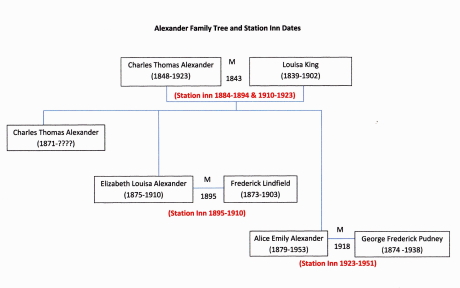
Alexander family tree (Station Inn dates in red)
Behaviour
Two reports appeared in the Brighton Gazette relating to the Station Inn. On the 25th October 1866 a case from the County Bench at Hove records that Frank Cartmile was summoned under the Refreshment Act for having been ‘quarrelsome’ in the Station Inn and ‘refusing to quit it’. He was fined ‘12s including costs, in default of payment to be imprisoned for a week’.
The second incident did not take place in the Station Inn but involved the son of the landlord William Pennicott.

Brighton Gazette February 28 1867
The incident took place in Waterloo Street when a group of boys harassed Walter Carcass who attempted to kick one of the boys but instead kicked William Pennicott. Although he denied the kick was intended to cause harm he was fined 10s with a default on payment resulting in two weeks committal. Walter Carcass’s two oldest sons, Walter and Philip, were also Punch and Judy exhibitors. The Eastbourne Gazette 13th March 1878 reported on a case at Brighton Borough Bench where Walter Carcass was charged with assault (it is not clear if this was father or son). The police superintendent stated that ‘he and his family were well known to the police as a ruffianly set, and were no strangers to the Bench’. He was sentenced to one month’s imprisonment with hard labour. Walter Carcass jnr. became a travelling exhibitor and multiple newspaper reports suggest a turbulent and troublesome life. The second son Philip remained in Brighton and became ‘Professor P Carcass’ operating a Punch & Judy stall until his death in 1938.
The Brighton Gazette September 12 1877 reports on the Hove Annual Licencing Session. The article includes the annual report from the Chief Superintendent of Hove Police, George Breach who states that ‘There are 21 public houses and 15 beerhouses in this town.’ He also reports that ‘considering the very large number of workpeople employed in Hove and on the new railway works’ that the public houses in his division ‘have been generally well conducted’.
Whats in a name?
And so to the myth which surrounds the name of this establishment. Convention has it that the Station Inn stood on land previously occupied by, or was a building converted from, the old Brunswick Town police station and fire house. There is also a suggestion that the old police cells were underneath the building. Given that the building stands next to what was the extension to the original town hall on land previously purchased by the Commissioners this seems unlikely to be the case, the name simply reflecting the buildings position next to the police station.
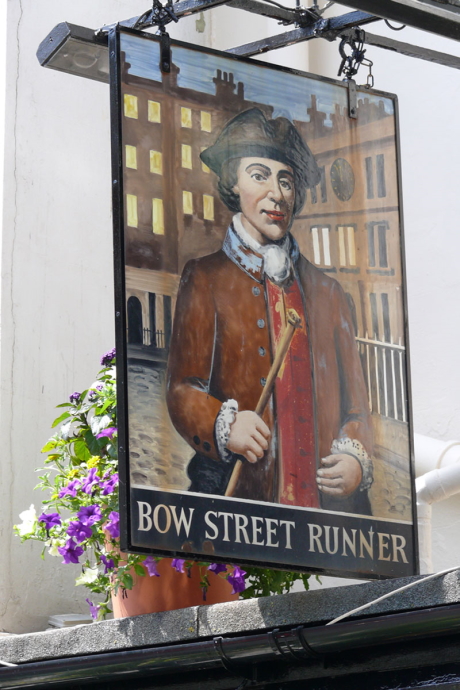
Current sign of the Bow Street Runner
In the 1960’s the name was changed to the Bow Street Runner. This reflects the origins of the original name, the Bow Street Runners being named in honour of London’s first professional police force founded by Henry and John Fielding in 1749. It has been suggested that the reason for the change in name came about because the landlord at the time became fed up when customers ‘enquired about the time of the next train’. It is however an enduring myth and one which only adds to the character of the pub.
Of the three original licensed premises in Brunswick Street West, the Bow Street Runner is the only one still in operation. According to the pub website the current landlady took over the pub in 2010 and in 2011 the two upper floors were converted to 3 en-suite bed and breakfast rooms.
Research by Thomas Aird (January 2023)
Thanks are also due to Philip Godsiff for providing additional photographs and information on George and Alice Pudney and Leslie Godsiff, and for allowing us to reproduce the photographs in this article. Philip is the great nephew to George and Alice and his father is Leslie Godsiff. His mother is Joyce Brown who appears in some of the photographs along with his grandmother Dora (sister to George Pudney) and his uncle Sidney.
Return to Brunswick Street West page
For information on how to join us as a research volunteer visit this page.


